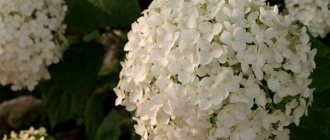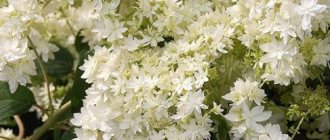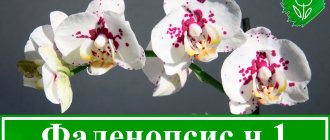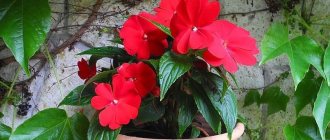Plants » Flowers
0
329
Article rating
Kira Stoletova
Among all the ornamental shrubs, Pink Annabelle hydrangea is one of the most popular plants. A relatively new variety, valued for its large inflorescences and good frost resistance, is grown everywhere. Let's look at what this crop looks like, how to plant and care for it correctly.
Hydrangea pink Annabelle
general characteristics
The variety is fast-growing, frost-resistant, belongs to the group of tree-like hydrangeas. Botanical name: hydrangea arborescens pink annabelle. External description:
- bush with a spherical crown;
- the shoots are green, slightly pubescent, strong, erect, so the plant looks compact;
- leaves are emerald, oblong or ovoid with a sharp tip and jagged edges;
- The flowers are pink, small, collected in dense, large inflorescences with a circumference of 30 cm.
The culture is valued for its abundant flowering, which begins in June and ends in September.
Landing Features
The success of growing hydrangea depends on compliance with the timing, planting rules and further care.
Disembarkation times vary depending on the region:
- in the south, in the Middle and Central zone - spring and early autumn;
- in areas with harsh climatic conditions - mid-spring (so that the bushes have time to take root and prepare for winter during the season).
Organization of the place
The plant prefers to grow in sunny places where there is good light in the morning and evening. When planting in the southern corner of the garden, it needs shading, because the leaves and flowers fade quickly.
You should not plant under the walls of a house, tall and spreading trees, where there is constant shade. At this point, the hydrangea stops growing, the leaves become pale, and the flowering is poor.
The soil is light, loose and highly acidic. When planted on alkaline soil, the foliage turns yellow; on calcareous soil, growth is retarded and the flowers do not bloom so abundantly and colorfully.
Preparation of planting material
You can purchase Pink Annabelle hydrangea in one of the specialized stores or nurseries.
The best material is considered to be seedlings 2-3 years old with closed roots (in an earthen coma or container). Such plants have a well-developed root system and crown. In addition, they take root faster and better after transplantation to the site.
When purchasing, carefully inspect the shoots and foliage - they should not be yellow, black spots, growths or mechanical injuries. If the leaves do not fall off when shaking, it means the plant is fresh.
The substrate is slightly moist, without mold or acidification on the surface.
Before planting, the root system needs to be trimmed a little to stimulate the development of new roots.
Landing technology
The planting site is prepared two weeks before the planned planting of seedlings - all garden debris and plant debris are removed, dug up, and leveled.
Pink Annabelle Hydrangea
Dig holes slightly larger than the size of the root system. Approximate dimensions are 55x50 cm. Drainage (pebbles, crushed stone or screenings) is placed at the bottom to ensure good drainage of moisture from the roots. A nutritious composition of peat, leaf soil, humus and sand, mixed in equal quantities, is sprinkled on top.
The roots are lowered, straightened, covered with the remaining soil mixture, compacted, and watered. Consumption per bush is 10 liters of water. To prevent the soil from drying out, the tree trunk area is mulched with peat or humus.
When growing in groups, you should adhere to the 3x2 m pattern. This way, the plants will fully develop and there will be no competition for moisture and nutrients.
In the first two weeks, seedlings are very sensitive to sunlight and can quickly burn out. Therefore, during lunch hours they are shaded with agrofibre or burlap.
Botanical description
Hydrangea Pink Annabelle tree is bred on the basis of the much-loved Annabelle variety.
Characteristics of the variety:
- Bushes . They reach a height of 90–120 cm. The crown is loose. They have thin but strong shoots that do not bend under the weight of heavy inflorescences. The color of young branches is green, gradually turning into light brown.
- Flowers . The somewhat flattened inflorescences have the shape of a hemisphere. The flowers are four-petalled and have a regular shape. The color of the flowers changes. At the beginning, the upper part of the petals is colored pale pink, the lower part is dark pink. Over time, the entire inflorescence evenly turns a rich pink color. As flowering fades, a gray tint appears.
- Flowering period . Flowers form on new shoots. Flowering lasts from late June-July to September.
- Leaves . Oval shaped, large. The color is bright green above, with a bluish tint below. The leaf is round at the base, serrated at the edge.
The plant is frost-resistant and even after harsh winters it quickly grows and regains its shape. It is unpretentious to soil quality, but develops better in slightly acidic soil.
Did you know? Pink Annabelle differs from other tree-like varieties in that it can bloom again after 1.5 months if pruned after the first flowering.
Care requirements
Watering
Watering should be moderate but frequent:
- in summer - once a week;
- closer to autumn - once every 20 days.
Up to 20 liters are poured under one bush. Use settled water at room temperature.
The next day, the soil is loosened so that it allows moisture and oxygen to pass through well. Periodically remove weeds, which are an excellent breeding ground for pests and infections.
After this, mulch with a thick layer of peat to protect the soil from drying out quickly.
Feeding
For high-quality and long-lasting flowering, this shrub needs nutrients. It is necessary to fertilize Anabel rosea hydrangea twice:
- in mid-March, mullein solution - 1:10;
- In the summer, before budding begins, a complex of mineral fertilizers is added - superphosphate, potassium nitrate and urea in a 2:1:1 ratio.
Additionally, the plant can be watered with fertilizer containing a high content of iron and magnesium. This will help prevent the development of chlorosis.
Trimming
The optimal time to carry it out is late autumn, when flowering ends and the plant sheds its leaves. Cut off dried inflorescences and branches that have been damaged by diseases and parasites.
Hydrangea tree pink anabel
Strong, faded branches are cut to 5 cm in length, the rest are cut to the very base. This pruning will stimulate lush flowering next year and strengthen the remaining stems.
All procedures are carried out using a sharp and sterile instrument. The cut areas are treated with copper sulfate to avoid infection.
Care during the flowering period
The main task of the gardener is to achieve the longest flowering possible. The plant continues to be watered, loosened the soil, and buds that have already bloomed are removed.
Nutrition is not carried out during the flowering period, because fertilizers, especially those with a high nitrogen content, inhibit the budding process.
Care after flowering
At the end of this process, the plant needs strength to recover in order to produce new buds and grow fully next year.
Compost or humus is added to the tree trunk area - consumption per bush is 5 kg. After this, abundant watering is carried out. They also cut out all non-viable parts that only take away nutrients and moisture.
Preparing for winter
Hydrangea Pink Annabelle has good winter hardiness and frost resistance, so it needs light insulation.
On the eve of the first frost, the branches are carefully bent to the ground, pinned, then sprinkled with fallen leaves. To prevent the shelter from being blown away by the wind, you can lay spruce branches on top.
Covering material is removed in the spring, when the snow has thawed and the threat of return frosts has passed.
Winter hardiness of hydrangea variety Pink Anabel
Most types of hydrangea require greenhouse conditions for the winter period, which include insulating the soil, covering the bush with several layers of polyethylene, etc. However, with tree varieties everything is simpler; they tolerate winter well. Only minor hilling is required, as well as pruning of faded inflorescences. The latter is done for the reason that the shoots may break under the weight of snow. On the other hand, if the grower is ready to regularly shake off the accumulating snow on the plant, then there is no need to trim the inflorescences. Moreover, thanks to their integrity, the buds located inside the bush will be better preserved.
Non-woody shoots require special attention; they should be cut off, as they will not survive the winter.
Reproduction methods
For tree hydrangea, gardeners use several propagation methods.
Pink Anabel variety of tree hydrangea
Cuttings
Cuttings are cut in the fall during sanitary cutting. At the top of the stems, select the strongest branches with several leaves and buds. The shoots of the current year that have not bloomed have the best survival rate. The optimal length is 15-20 cm.
In the lower part, all foliage is removed, then dipped in one of the growth stimulants for an hour. After this time, they are planted in a light, loose and well-moistened mixture of peat and sand. Planting depth is 3-4 cm. Each cutting is covered with half a transparent plastic bottle to create a greenhouse effect.
Before the onset of persistent cold weather, the seedlings are covered with burlap or agrofibre. When grown in a harsh climate zone, it is better to dig them up and transplant them into pots. In May, when the threat of return frosts has passed, it should be returned to its original habitat in the open ground.
Stem layering
Hydrangea pink anabelle successfully reproduces by layering. Choose an adult bush with good branching. A shallow trench (5-6 cm) is dug next to it. Sprinkle with a mixture of peat, sand and humus (1:1:1). Select the most flexible branch closest to the ground. Remove all the leaves on it, lower it horizontally into the groove, and pin it with staples. Sprinkle the branch with the remaining fertile soil and water it.
A week before persistent cold weather, cover with fallen leaves, pine sawdust or spruce branches. This will create additional protection against freezing in winter.
With the arrival of spring, when the snow thaws and the street heat stabilizes, the branch is dug up and cut off from the mother bush. Divide into several parts with roots, plant on the site according to the above described scheme.
Dividing the bush
This method is used for old plants that need rejuvenation. You can determine that a bush needs to be rejuvenated by its general condition - it stops growing, blooms sparingly, or does not produce inflorescences at all.
First, water the hydrangea abundantly, and after an hour, carefully dig it in to prevent injury to the roots. Remove and wash the root system under running water. Let it dry a little, then divide it into several parts with a garden shovel. It is important that each division has 2-3 shoots and roots left.
To avoid infection, the cut sites are treated with copper sulfate, and after drying, they are planted on the site.
Why doesn't it bloom
If the bush does not bloom, then there are reasons for this:
- shoots were pruned incorrectly in April;
- insufficient watering and nutrition;
- the roots of the plant are underdeveloped;
- Flowering was artificially stimulated in the nursery. Due to the addition of this kind of product, hydrangea may not bloom for years. To resume the flowering process, it is necessary to continue treatment with a growth stimulator;
- Tissue death occurred due to too severe frost.
But if the shrub is already blooming, then you need to know about the slight difference in the plant. Representatives of this variety can change the shade of flowering. To get this effect, you just need to add drugs that change the pH of the soil. By absorbing coloring elements, they spread throughout the tissues and affect the pigmentation of the petals.
Important! To get blue instead of white, you will need to add products that contain aluminum to the soil
Diseases and pests
The Annabelle Pink variety rarely gets sick; a decrease in immunity is possible only if the rules of planting, care and maintenance are violated:
Hydrangea pink Anabel variety description photo
- Powdery mildew may appear on weakened bushes. It appears as a whitish coating, which becomes yellow-brown over time. Areas damaged by the fungus rot and die. Getting rid of this sore is not difficult - first you need to cut out the diseased areas, then irrigate the crown with copper-containing preparations (copper sulfate or Bordeaux mixture).
- The development of chlorosis occurs in hydrangeas growing on alkaline soil. With this disease, the foliage becomes pale, veins are clearly visible on the surface, and the bush stops blooming. To restore decorative properties, it is necessary to fertilize with fertilizers with a high iron content.
- Spider mite. Appears during periods of extreme heat and drought. It envelops the underside of the leaves in a fine web and sucks the juices out of them. Affected leaves turn yellow and fall off. For treatment, acaricides are used - Actellik or Aktaru.
To protect garden hydrangeas from diseases and pests, you must follow a number of simple measures:
- buy fresh and healthy seedlings;
- avoid crowding when planting;
- remove weeds and loosen the soil in a timely manner;
- provide regular hydration and nutrition;
- cut out diseased areas on the bush in a timely manner.
How is it different from Strong Annabelle hydrangea?
Hortense Strong Annabelle is one of the varieties of Annabelle.
These two cultures are very similar to each other, but still, there are differences:
- Strong Annabel's flowering is more lush and abundant, her flowers are larger;
- Annabelle blooms only for 3 summer months, Strong Annabelle - the entire summer period and almost until mid-autumn;
- Strong Annabelle stems are much stronger and more stable, they do not require additional strengthening, they are not afraid of wind and rain, which cannot be said about Annabelle, which bends to the ground in windy and rainy weather, becomes disheveled, and can be damaged;
- Annabelle's leaves retain their green freshness until the onset of frost; Strong Annabelle's leaves begin to turn yellow much earlier.
Strong Annabelle is an amazing plant, characterized by the presence of a number of distinctive features. To appreciate all the beauty and sophistication of this culture, you need to be able to handle it correctly. And then for almost six months you will have the opportunity to admire this magnificent beauty.
Application in landscape design
Hydrangea is suitable for creating different compositions in the garden:
Hydrangea anabelle pink
- the bush is planted singly in the center or along the edges of the garden, where it is necessary to create bright colorful landscaping;
- planted in groups in combination with varieties of tree hydrangeas of other colors;
- The shrub looks great surrounded by perennials - roses, junipers, dwarf fir;
- grown near gazebos and terraces;
- used in creating multi-level flowering compositions, planted in the background.











